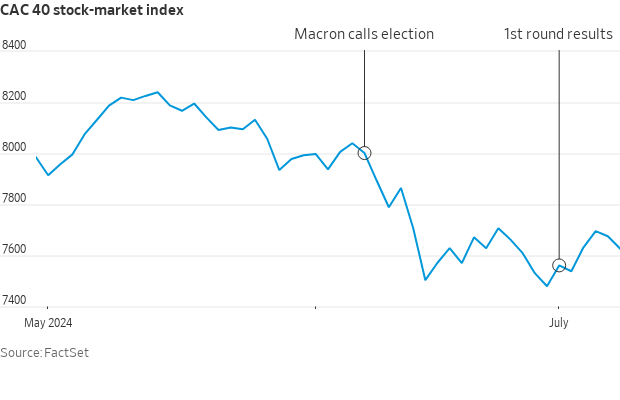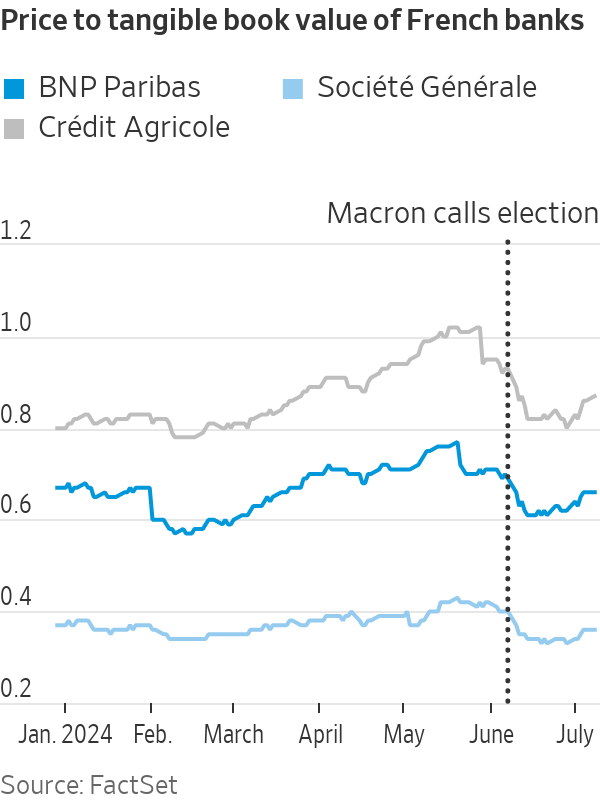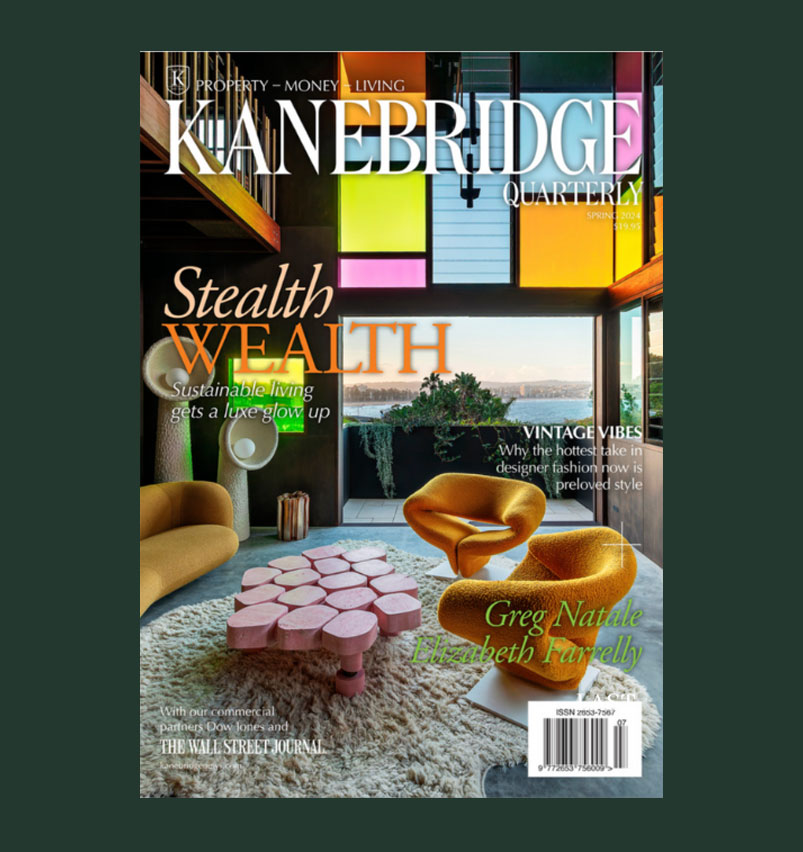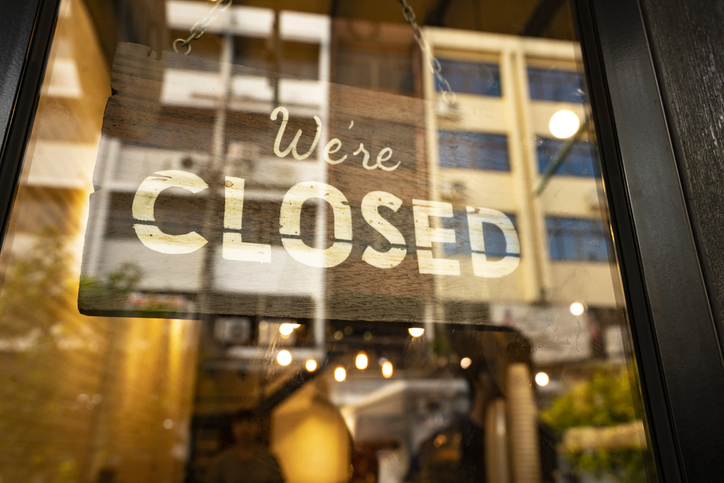In France, Investors Get the Centrist Limbo They Wanted
Polarisation has for years left the country’s politics stuck in an unpopular middle ground, and the latest elections won’t change that
When it comes to France’s turbulent politics , the current impasse is probably the best investors could have hoped for.
The second round of French legislative elections delivered a widely expected hung parliament, but not its predicted makeup: Rather than coming in first, Marine Le Pen ’s far-right and anti-immigrant National Rally finished third. In a shock twist , the leftist New Popular Front alliance emerged victorious, with the party of President Emmanuel Macron and its allies in second place.
This is because leftists and centrists ended up coordinating. In many local races, candidates dropped out to avoid dividing the vote against the far right. Still, no party has an outright majority, which plunges the country into political gridlock. This was, counterintuitively, the preferred outcome for financial markets.

The CAC 40 initially tumbled when the elections were called in June, driven by fears of a potential National Rally government challenging the European Union with fiscally expansive plans. Then the French stock benchmark perked up, as the first-round results suggested that the far-right wouldn’t get a majority.
Yet markets remained volatile because the rise of the New Popular Front raised even greater concerns. The policies of this coalition, in which leftist firebrand Jean-Luc Mélenchon is a key leader, also include more public spending, on top of widespread tax increases. Indeed, the CAC 40 closed down 0.6% Monday, probably reflecting investors’ concerns about these parties potentially managing to form a new government. Mélenchon has stated that there will be no deals with the centrists.
These worries seem overblown. Yes, there are doubts about how France will handle its budget deficit, which amounted to 5.5% of gross domestic product in 2023 and has forced the EU to launch an “excessive deficit procedure” against the country. Macron may need to accept the reversal of reforms such as a higher retirement age.
Still, a fiscal crisis isn’t in the cards, because the European Central Bank is ultimately in control of France’s bond market.
As for economic growth, it is unclear how much impact Macron’s policies have had in the first place, particularly given resistance from unions and swaths of the public, which resulted in the famous “yellow vest” protests in 2018 and 2020.
What matters for sectors battered in the stock market, including banks, energy firms and infrastructure operators, is that the risk of widespread tax increases, nationalisations and a prolonged standoff with Brussels seems smaller now than a few weeks ago. Whatever Mélenchon says, the left will either have to compromise or else form a minority government that might scare investors but wouldn’t be able to pass laws.

So there isn’t much justification for the lower valuation of lenders such as Société Générale and especially BNP Paribas —one of Europe’s most interesting banks that now trades at 0.65 times tangible book value. The same is likely true for firms such as energy utility Engie and infrastructure-concessions leader Vinci , which have lost 8% of their market value since the end of May.
These elections are more a symptom of Macron’s weakness than its cause. After a chaotic month, French politics is back where it has been for years, with a rising far right forcing the left to back a centrist platform that can achieve little because few people actually like it. Macron himself became president on an anti-Le Pen ticket, but in seven years has failed to rally broad support for his pro-business vision.
This could eventually make Le Pen’s victory inevitable, as she claimed after initial results came in. For now, though, it is more or less what markets ordered.
 Copyright 2020, Dow Jones & Company, Inc. All Rights Reserved Worldwide. LEARN MORE
Copyright 2020, Dow Jones & Company, Inc. All Rights Reserved Worldwide. LEARN MORE
This stylish family home combines a classic palette and finishes with a flexible floorplan
Just 55 minutes from Sydney, make this your creative getaway located in the majestic Hawkesbury region.
Impact investing is becoming more mainstream as larger, institutional asset owners drive more money into the sector, according to the nonprofit Global Impact Investing Network in New York.
In the GIIN’s State of the Market 2024 report, published late last month, researchers found that assets allocated to impact-investing strategies by repeat survey responders grew by a compound annual growth rate (CAGR) of 14% over the last five years.
These 71 responders to both the 2019 and 2024 surveys saw their total impact assets under management grow to US$249 billion this year from US$129 billion five years ago.
Medium- and large-size investors were largely responsible for the strong impact returns: Medium-size investors posted a median CAGR of 11% a year over the five-year period, and large-size investors posted a median CAGR of 14% a year.
Interestingly, the CAGR of assets held by small investors dropped by a median of 14% a year.
“When we drill down behind the compound annual growth of the assets that are being allocated to impact investing, it’s largely those larger investors that are actually driving it,” says Dean Hand, the GIIN’s chief research officer.
Overall, the GIIN surveyed 305 investors with a combined US$490 billion under management from 39 countries. Nearly three-quarters of the responders were investment managers, while 10% were foundations, and 3% were family offices. Development finance institutions, institutional asset owners, and companies represented most of the rest.
The majority of impact strategies are executed through private-equity, but public debt and equity have been the fastest-growing asset classes over the past five years, the report said. Public debt is growing at a CAGR of 32%, and public equity is growing at a CAGR of 19%. That compares to a CAGR of 17% for private equity and 7% for private debt.
According to the GIIN, the rise in public impact assets is being driven by larger investors, likely institutions.
Private equity has traditionally served as an ideal way to execute impact strategies, as it allows investors to select vehicles specifically designed to create a positive social or environmental impact by, for example, providing loans to smallholder farmers in Africa or by supporting fledging renewable energy technologies.
Future Returns: Preqin expects managers to rely on family offices, private banks, and individual investors for growth in the next six years
But today, institutional investors are looking across their portfolios—encompassing both private and public assets—to achieve their impact goals.
“Institutional asset owners are saying, ‘In the interests of our ultimate beneficiaries, we probably need to start driving these strategies across our assets,’” Hand says. Instead of carving out a dedicated impact strategy, these investors are taking “a holistic portfolio approach.”
An institutional manager may want to address issues such as climate change, healthcare costs, and local economic growth so it can support a better quality of life for its beneficiaries.
To achieve these goals, the manager could invest across a range of private debt, private equity, and real estate.
But the public markets offer opportunities, too. Using public debt, a manager could, for example, invest in green bonds, regional bank bonds, or healthcare social bonds. In public equity, it could invest in green-power storage technologies, minority-focused real-estate trusts, and in pharmaceutical and medical-care company stocks with the aim of influencing them to lower the costs of care, according to an example the GIIN lays out in a separate report on institutional strategies.
Influencing companies to act in the best interests of society and the environment is increasingly being done through such shareholder advocacy, either directly through ownership in individual stocks or through fund vehicles.
“They’re trying to move their portfolio companies to actually solving some of the challenges that exist,” Hand says.
Although the rate of growth in public strategies for impact is brisk, among survey respondents investments in public debt totaled only 12% of assets and just 7% in public equity. Private equity, however, grabs 43% of these investors’ assets.
Within private equity, Hand also discerns more evidence of maturity in the impact sector. That’s because more impact-oriented asset owners invest in mature and growth-stage companies, which are favored by larger asset owners that have more substantial assets to put to work.
The GIIN State of the Market report also found that impact asset owners are largely happy with both the financial performance and impact results of their holdings.
About three-quarters of those surveyed were seeking risk-adjusted, market-rate returns, although foundations were an exception as 68% sought below-market returns, the report said. Overall, 86% reported their investments were performing in line or above their expectations—even when their targets were not met—and 90% said the same for their impact returns.
Private-equity posted the strongest results, returning 17% on average, although that was less than the 19% targeted return. By contrast, public equity returned 11%, above a 10% target.
The fact some asset classes over performed and others underperformed, shows that “normal economic forces are at play in the market,” Hand says.
Although investors are satisfied with their impact performance, they are still dealing with a fragmented approach for measuring it, the report said. “Despite this, over two-thirds of investors are incorporating impact criteria into their investment governance documents, signalling a significant shift toward formalising impact considerations in decision-making processes,” it said.
Also, more investors are getting third-party verification of their results, which strengthens their accountability in the market.
“The satisfaction with performance is nice to see,” Hand says. “But we do need to see more about what’s happening in terms of investors being able to actually track both the impact performance in real terms as well as the financial performance in real terms.”
This stylish family home combines a classic palette and finishes with a flexible floorplan
Just 55 minutes from Sydney, make this your creative getaway located in the majestic Hawkesbury region.






















